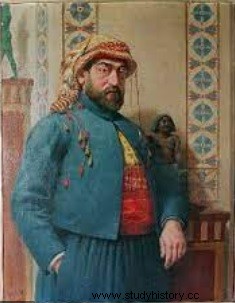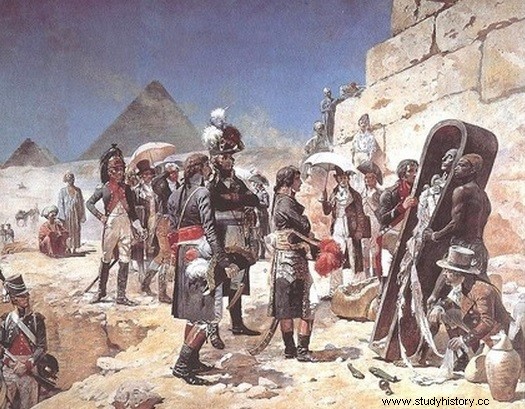 Egyptology , a scientific study of Egyptian civilization, was born in the 19th century, thanks to Bonaparte's campaign in Egypt and the decoding of hieroglyphics by Champollion . Despite the general enthusiasm for the ancient East, knowledge of this culture is restricted to a small committee of scholars. Auguste Mariette , one of them, will successfully strive to make it known to the general public. We also owe him the discovery of many pieces of ancient Egyptian art, exhibited in Cairo or the Louvre Museum in Paris.
Egyptology , a scientific study of Egyptian civilization, was born in the 19th century, thanks to Bonaparte's campaign in Egypt and the decoding of hieroglyphics by Champollion . Despite the general enthusiasm for the ancient East, knowledge of this culture is restricted to a small committee of scholars. Auguste Mariette , one of them, will successfully strive to make it known to the general public. We also owe him the discovery of many pieces of ancient Egyptian art, exhibited in Cairo or the Louvre Museum in Paris.
Napoleon's expedition, the origin of Egyptology
Egyptology began to develop in the 19th century. Since Antiquity, travelers have decided to make Egyptian civilization a subject of study. In the Middle Ages, pilgrims on their way to the Holy Land visited the places in Egypt mentioned in the Bible. But before the 19th century, their accounts lacked any scientific rigour. From 1798 to 1801, Napoleon's troops entered Egyptian territory. A science and arts commission accompanies them. They collaborated with the military to produce a colossal work, the Description of Egypt (1809-1822), a veritable inventory of knowledge about Egypt.
 If the expedition ends in failure, it closely links two different countries. Egyptian intellectuals are won over by a Francolatry to which the French respond with a passion for Egypt. In addition, the French military seized the Rosetta Stone, a key piece in the development of Egyptology. The deciphering of hieroglyphs by Champollion around 1809 led to the entry of this discipline into university curricula.
If the expedition ends in failure, it closely links two different countries. Egyptian intellectuals are won over by a Francolatry to which the French respond with a passion for Egypt. In addition, the French military seized the Rosetta Stone, a key piece in the development of Egyptology. The deciphering of hieroglyphs by Champollion around 1809 led to the entry of this discipline into university curricula.
Oriental fashion
The discovery of the richness of Eastern civilizations created a new fashion, followed by romantic writers and painters. In this regard, we can think of the Orientales, the collection by Hugo published in 1829, or even of various paintings by Delacroix. Travelers to these distant lands became more numerous, including Gustave Flaubert. In October 1849, he left Europe with the writer Maxime Du Camp. For a little over a year, they stayed in Constantinople, Greece, Syria, Palestine and Egypt.
Ancient monuments fascinated Flaubert who collected his impressions, his experiences, as well as numerous documents, essential for his oriental novels. He returned to France at the beginning of 1851. Before settling on Carthage for Salammbô, he hesitated to write an Egyptian novel. Like many of his contemporaries, Flaubert was especially passionate about the ancient Orient. He deplores the Europeanization of Eastern countries which, in his eyes, can only endure decadence. This is why he places Salammbô and (1862) and Herodias (1877) in antiquity.
Egyptian art imported to France
Many Egyptian works of art were imported into France, starting with the obelisk in Place de la Concorde, a gift from Viceroy Muhammad Ali to France in 1831. It arrived in Paris in 1836. Coming from the temple of Luxor, it is covered with hieroglyphs which exalt the reign of Ramses II (c. 1304-1236 BC)
Apart from the control of the Egyptian authorities, no regulations regulated the purchase of Egyptian works of art in the 19th century. Through private and public collections, statues, obelisks and other pieces of architecture can be admired in France. They promote the values and aesthetic canons of the land of the pharaohs.
Auguste Mariette, the precursor
 Egyptologist Auguste Mariette plays an important role in this regard. Employed in the Department of Egyptian Antiquities at the Louvre Museum, he was sent to Egypt where he began archaeological excavations in the royal necropolis of Saqqara.
Egyptologist Auguste Mariette plays an important role in this regard. Employed in the Department of Egyptian Antiquities at the Louvre Museum, he was sent to Egypt where he began archaeological excavations in the royal necropolis of Saqqara.
In 1858, he created the Egyptian Antiquities Service, of which he became the first director, and founded a museum that would become the Egyptian Museum in Cairo. Mariette is halfway between the rigor essential to any archaeological work and the desire to make known to the public the wonders from Egypt. He is in charge of Egyptian participation in universal exhibitions and the creation of Aïda.
World Fairs
In 1867, notables, bourgeois and common people rushed to Paris, on the occasion of the Universal Exhibition. In all, there are some seven million visitors, eager to be able to walk in the Egyptian park. This is made up of four constructions that evoke pharaonic, Muslim and modern Egypt. It also includes different curiosities like mummy skulls or jewelry.
 The ancient temple arouses the greatest interest among the public. Scientifically reconstructed, it also serves as a museum. It houses pieces from Cairo that give an overview of the evolution of Egyptian architecture. Following the success obtained in 1867, Mariette participated in other Universal Exhibitions, notably that of 1878 for which he reproduced an ancient Egyptian house.
The ancient temple arouses the greatest interest among the public. Scientifically reconstructed, it also serves as a museum. It houses pieces from Cairo that give an overview of the evolution of Egyptian architecture. Following the success obtained in 1867, Mariette participated in other Universal Exhibitions, notably that of 1878 for which he reproduced an ancient Egyptian house.
Aida, the first "peplum"
The park of the 1867 exhibition arouses in the public the desire for a living representation of Egyptian civilization. But Mariette deplores the inaccuracy of the sets and costumes created. He then decided to put his erudition at the service of art and developed the scenario for Aïda, an opera by Verdi commissioned by Ismaïl Pasha, the viceroy of Egypt. He also controlled the making of the costumes when the show was first performed in Cairo in 1871.
This time, he lets himself be carried away by his imagination and aesthetics ends up prevailing over scientific rigor. Mariette finds it difficult to adapt the events represented in the temples to the demands of the modern opera scene. He also demanded that the singers give up their anachronistic beards and mustaches but was refused. This infidelity provoked mockery from critics during the first performance in Cairo. Despite everything, the quality it brings perfectly completes the exotic evocation of Pharaonic Egypt.
During the following decades and until today, the public enthusiasm for Egyptology will remain constant; Witness the recent success of the Tutankhamun Exhibition at La Villette in 2019.
To go further
- Auguste Mariette:An Adventurer-Egyptologist, by Amandine Marshall. Ancient Worlds, 2021.
- "From the top of these pyramids...":The Egyptian expedition and the birth of Egyptology (1798-1850). fage editions, 2014.
- The Universal Exhibition of 1867. BNF, 2013.
